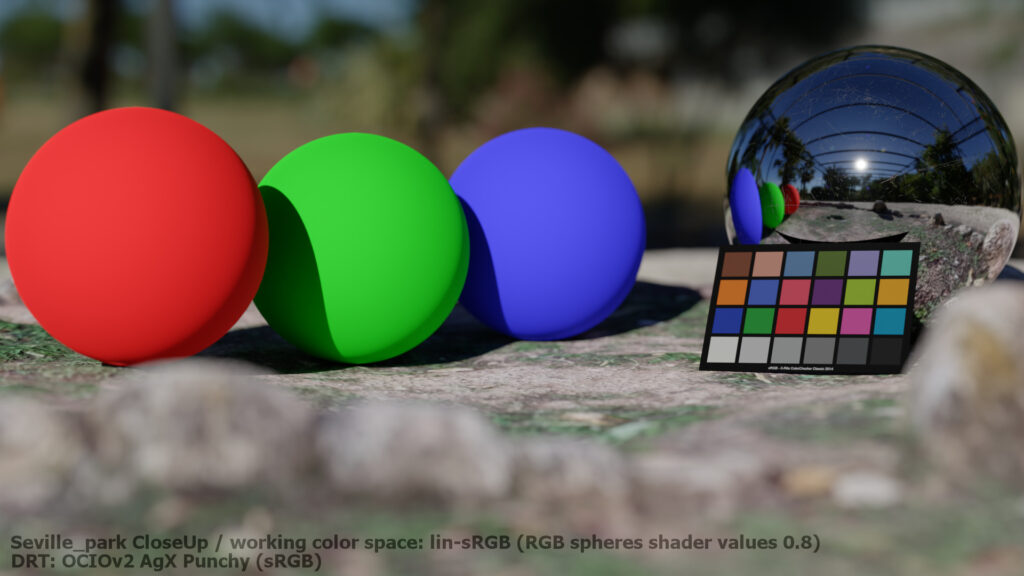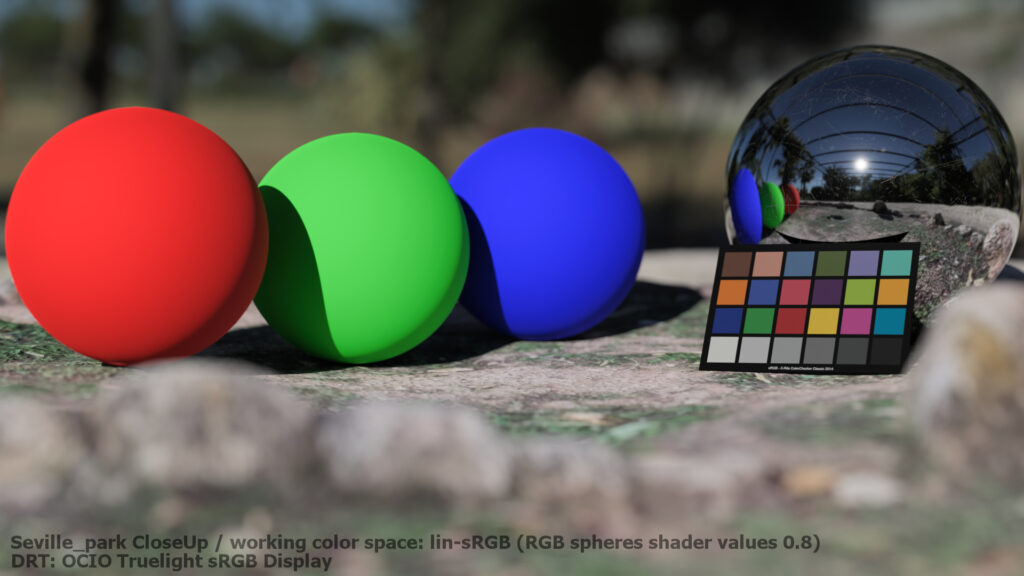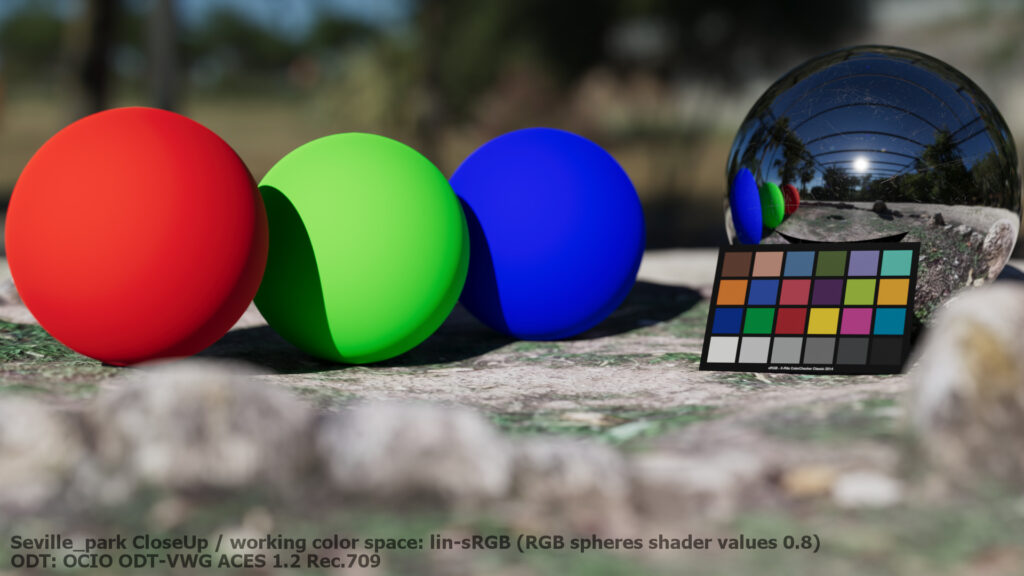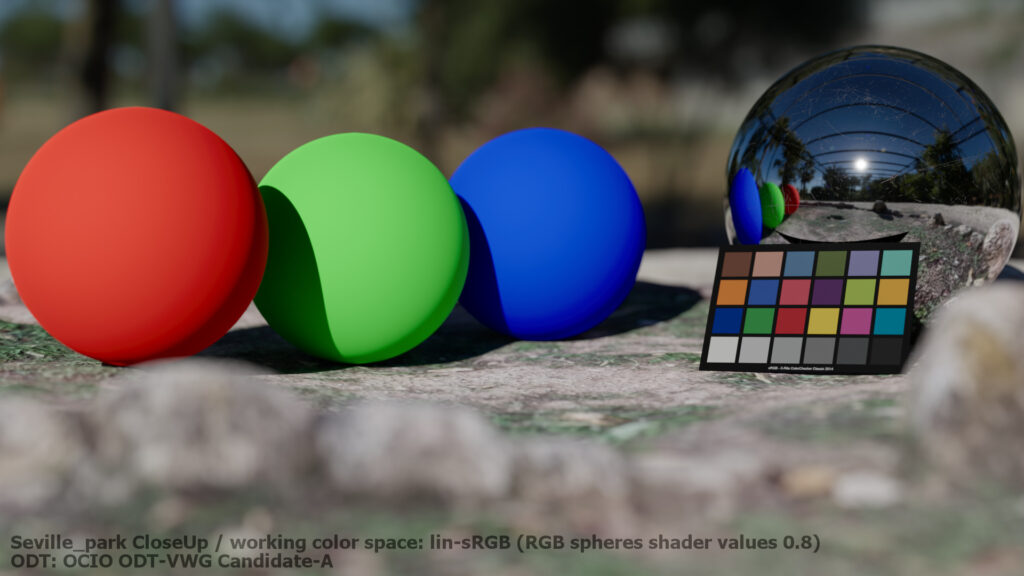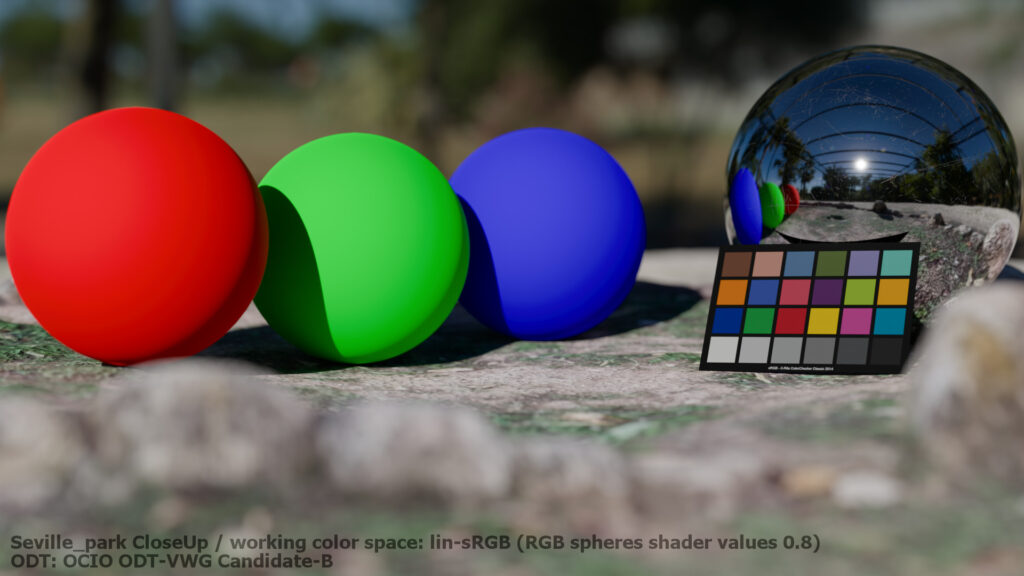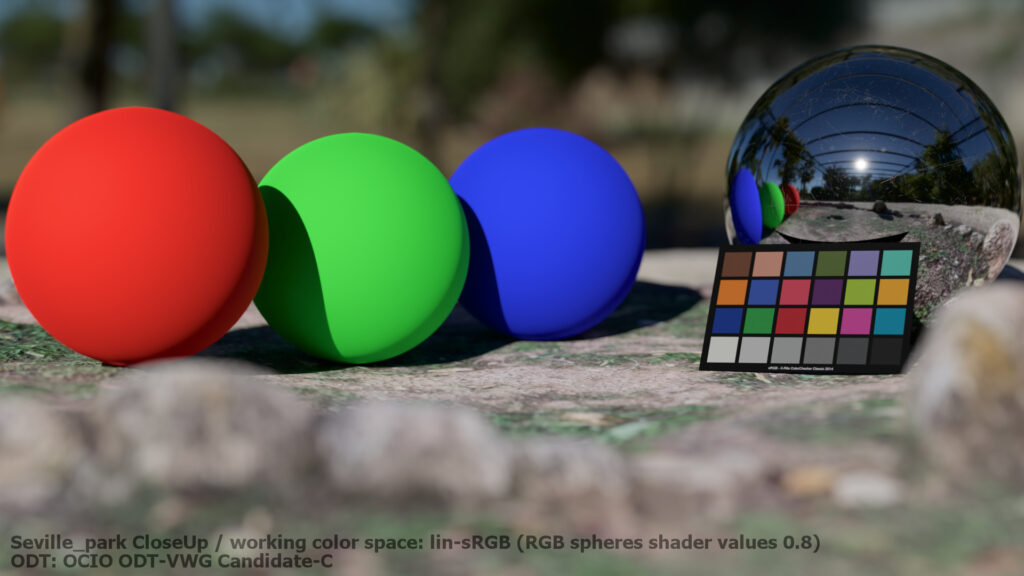Taking one Blender rendering and view it through SEVERAL view transforms in SDR and HDR.
For the article 1.4.2. Blender 3.2 render colorspace overrides I set up a small Blender scene. At the same time I re-checked the CG OCIOv2 config and I thought: Why not comparing all the latest display rendering transforms or view transforms that are easily available to me and see what images will come out of them.
This time I rendered another closeup of the same Blender scene. To make the camera move a bit more interesting I tested the Blender AddOn VirtuCamera and recorded the hand held camera animation live with an iPhone13Pro. A clip can be found at the end of this article.
the blender scene specs
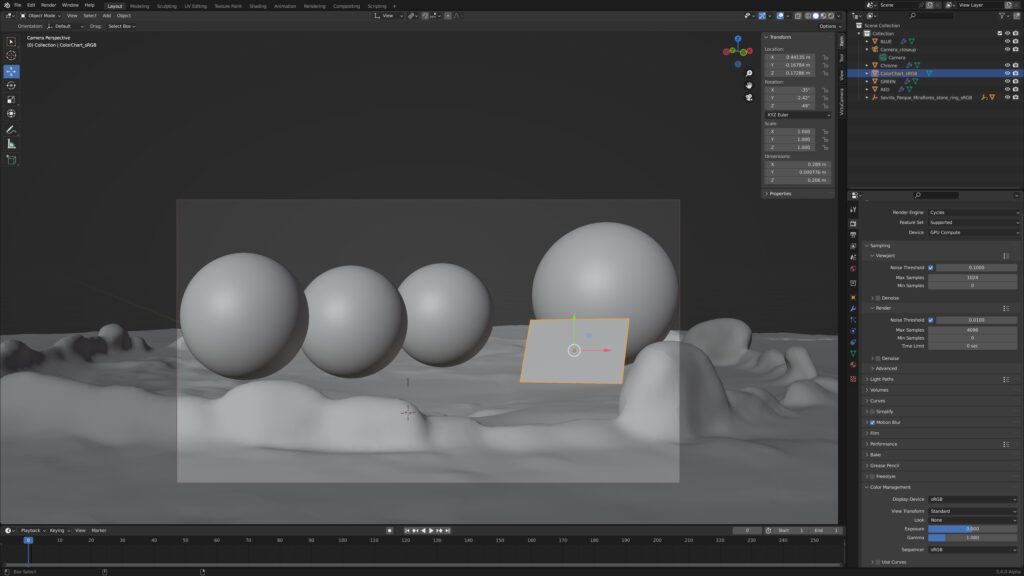
Blender is set to use the default working colourspace linear-sRGB. The scene contains a linear-sRGB balanced HDRI, a sRGB-tagged (.jpg) texture file from Scaniverse, three RGB spheres with a RGB base color of 0.800 or 80% reflectance of the incoming light, a chrome ball and a sRGB color checker. The EXR render output is balanced and exposure adjusted in Nuke for the sRGB JPG output so that the middle grey patch has a value of approx 0.39 in scene linear or RGB 100/100/100 on this page.
Different rendering transforms will end up with the middle grey patch at different levels at the display. I compensated for this fact and exposure adjusted the image data for all the images on this page. In this way you won’t get distracted by overall brighter and darker images.
A small note and page update – I got some feedback for this article:
Although this is a very “artificial” scene setup in Blender and I noted down in the article later that the three coloured spheres are “sticking” out in the image because of their high color saturation, it is a good question what kind of material would reflect 80% of the incoming light in such a pure way for red, green and blue?
I found on YouTube a video called “PBR Color Reference List for Materials – by Grzegorz Baran“. I bought the PDF and will go through it soon to check where I can find such pure materials. And I also plan to look for some coloured balls in a toy shop and try to “re-shoot” the Blender scene on the real location with my Canon 7D.
the rendered image
The EXR file that comes out of Blender contains image data, but it is not really an image yet. It contains pixel values over 6500 in the center of the sun on the chrome ball for example. And there are also some values on the coloured spheres on their highlight side that are over 1.
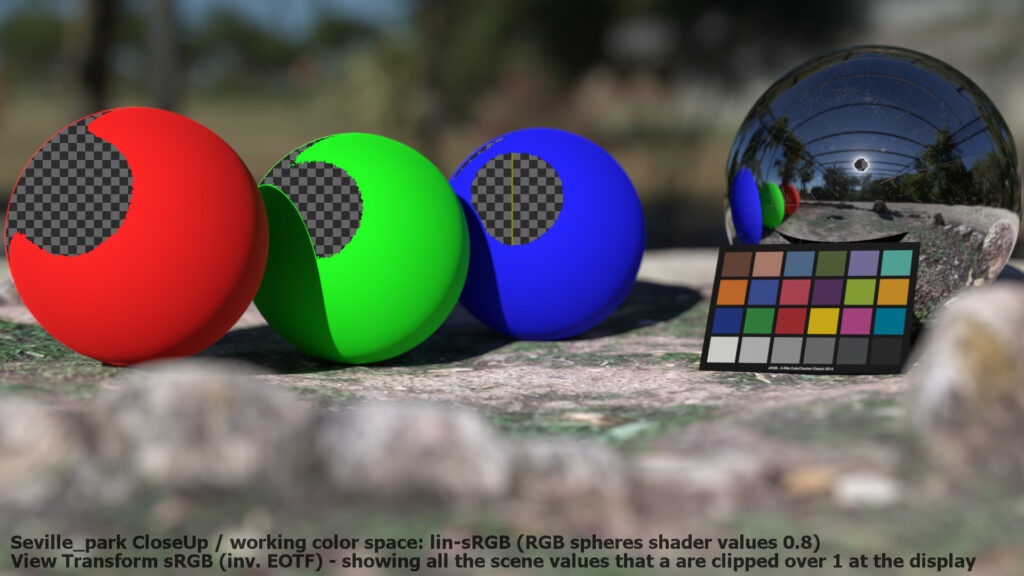
A display can only decode values between 0-1, so there is some image processing (tone-mapping) and encoding for the display (inverse EOTF) needed in order to present an “expected” image out of the image data.
I setup up the Blender scene while I had the standard sRGB view transform (inv. EOTF) enabled, so you can say the first image is the intended version of the rendering. All the other following images are “interpretations” of the same blender “scene”. Pick your favourite image.
Here you can download the rendering from blender.
Standard sRGB, Blender Filmic, AgX, Open-DRT and T-Cam
notes about the images from top to bottom
- sRGB (inv. EOTF)
- The image looks good, but comparing the three coloured spheres next to the “natural” coloured patches on the color checker, one might argue that the three spheres look a bit oversaturated and standing out too much. The highlight of the sun on the chrome sphere shows the hard clipping of values at the maximum display emission limit.
- Blender Filmic Log encoding with the look “Medium High Contrast”
- All the coloured spheres appear a bit darker, there is less of a highlight visible and therefore the spheres appear to be a bit more flat. The blue sphere appears more saturated than in the first image. The chrome sphere highlight has a much softer and more realistic falloff.
- AgX Punchy
- The coloured spheres getting brighter again and gain more shading and volume again, but the blue sphere appears a bit magenta. Compared to the first image the spheres look flat and desaturated, but next to the natural coloured patches on the color checker the three spheres feel better integrated in the image and not no stand out so much.
- OpenDRT
- The blue sphere stays blue and the spheres overall feel to have more depth, are more spherical. This seems due to the slight highlight shading towards the sun.
- TrueLight
- The red sphere feels a bit brighter and all spheres show a bit more saturation.
Just scroll up and pass through the images again and again. There is a lot to compare and discover in this rather simple setup. My favourites are the first and the last image of the five.
AcesCentral.com ODT-vWG – ACES 1.2 Rec.709, Candidate a,B,C
I am attending the virtual working group meetings for the next ACES 2.0 release on ACESCentral.com. A test package with three candidates is now available on ACESCentral.com. The following images are created in Nuke with a preview version of this test package.
To be clear, the following four images are based on the same EXR file as the five display rendering transforms above. All the time I only show different interpretations of the same image data.
A lot of the test images that are used to test the new ACES ODT candidates feature very strong lighting conditions. For my test I choose deliberately a 3D scene which has a normal daylight exposure and does not feature rendering primaries that are out of the bounds of the limited sRGB/Rec.709 gamut. As this rendering can be displayed with a simple inv. EOTF it makes it easier for me to compare it to the different display rendering transforms.
Notes about the ACES 1.2 image and the three candidates
- ACES 1.2
- The red sphere has a slight orange highlight area, the green sphere get a slight shift to yellow on the highlight area as well, whereas the blue sphere looks very oversaturated and rather flat.
- ODT Candidate-A
- All spheres look more desaturated, the blue sphere seem to improve, because it gets a lot more shading and volume, but there is a banding ring in the darker shadow area.
- ODT Candidate-B
- Here the blue sphere looses even more, because it gets magenta on the highlight area plus the banding in the dark shadow areas. The green and the red sphere are looking more saturated again without any color shift in the highlight areas.
- ODT Candidate-C
- Again a bit less saturated than Can-B, overall the cleanest result of the three candidates.
The three ODT candidates are baked LUT’s at the moment, so some banding issues could come from this side.
Once again here are all the 9 images from the two test rows together. My favourites are now the top/left (inv. EOTF sRGB) image , the center image (T-Cam) and the lower right image (ACES Candidate-C).
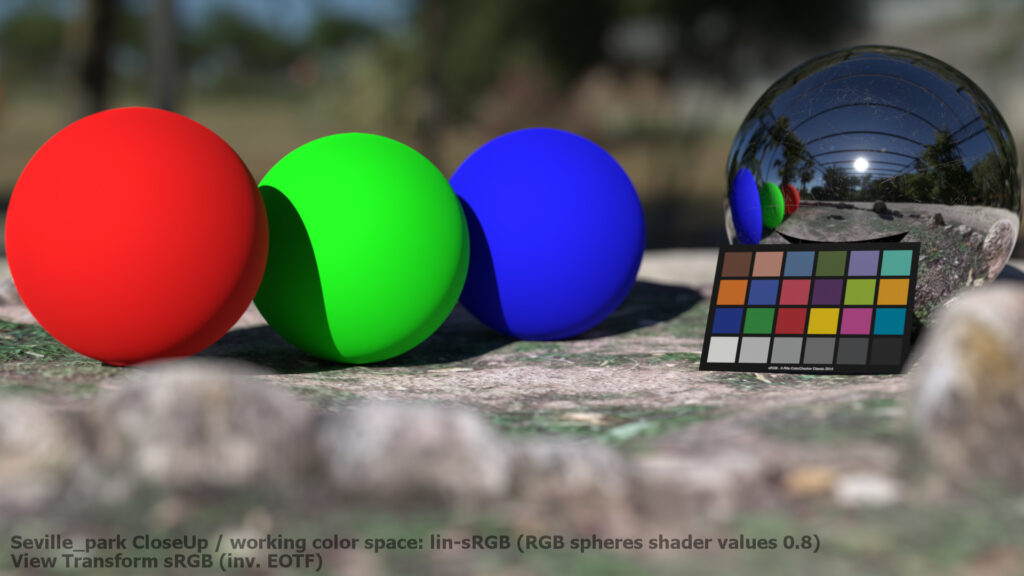
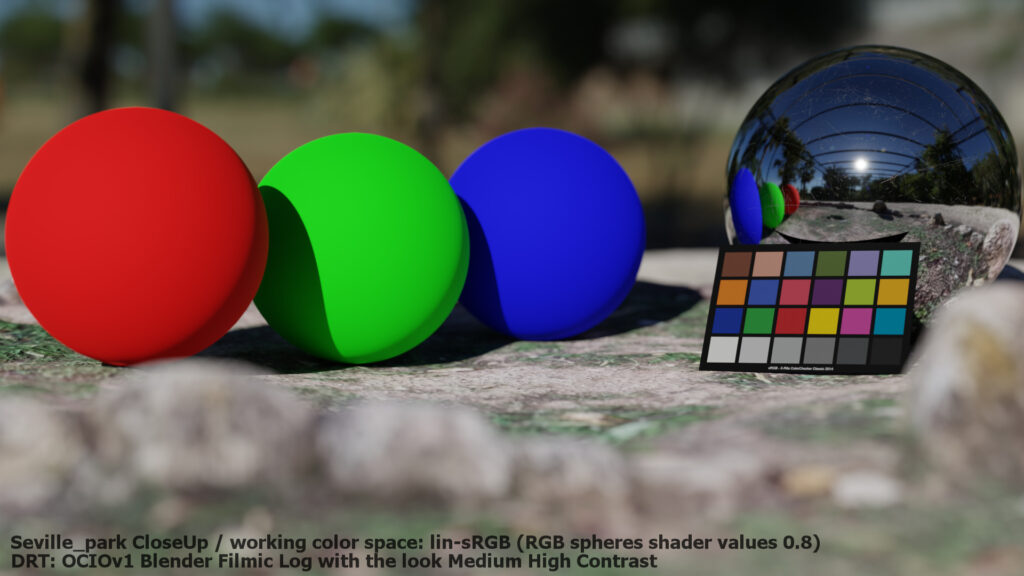
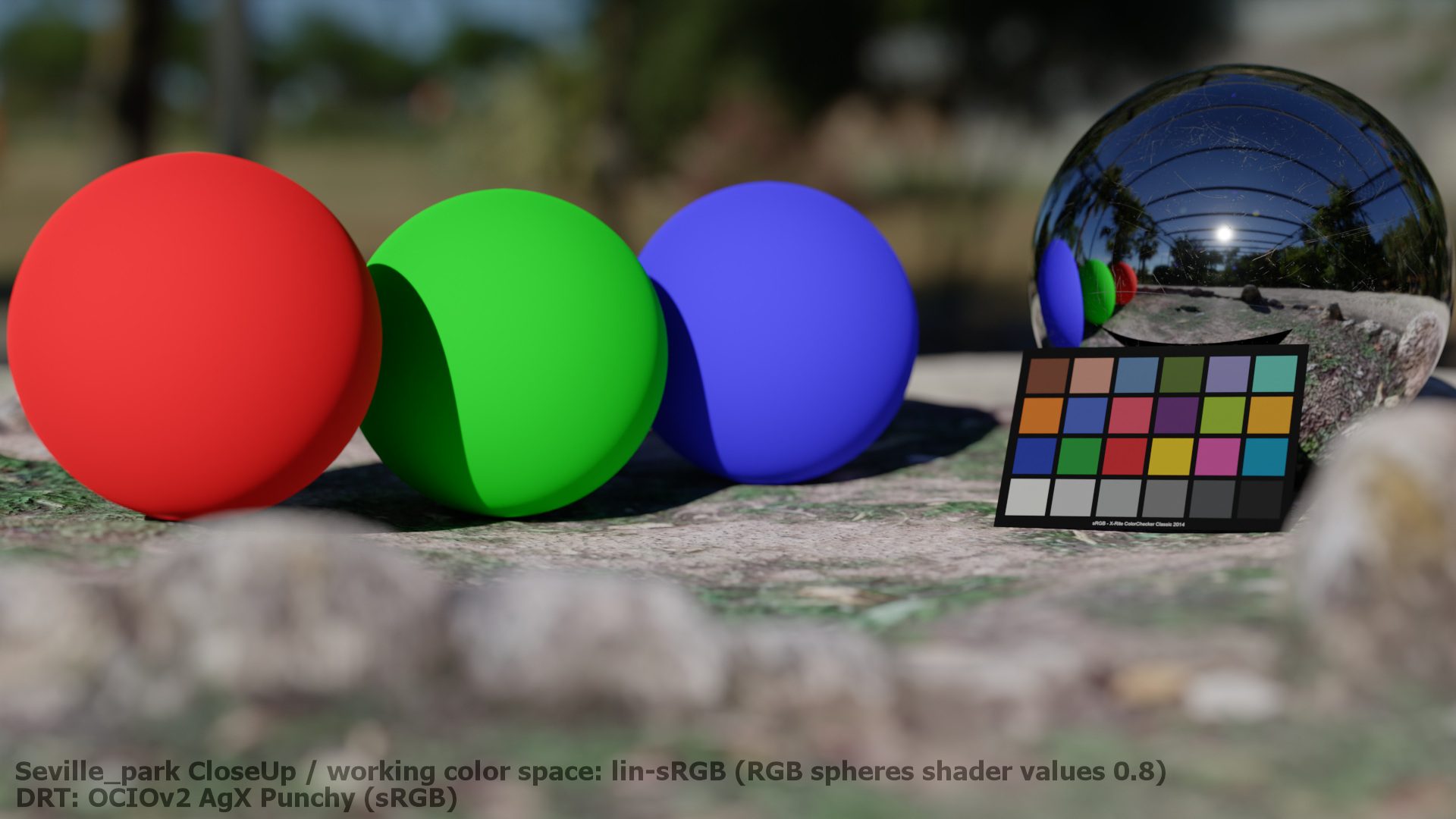
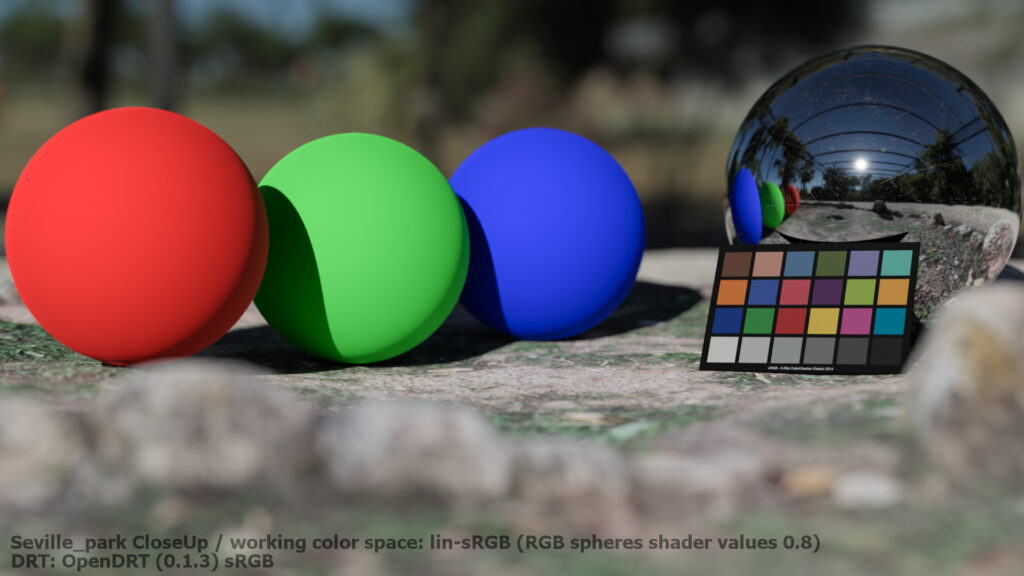

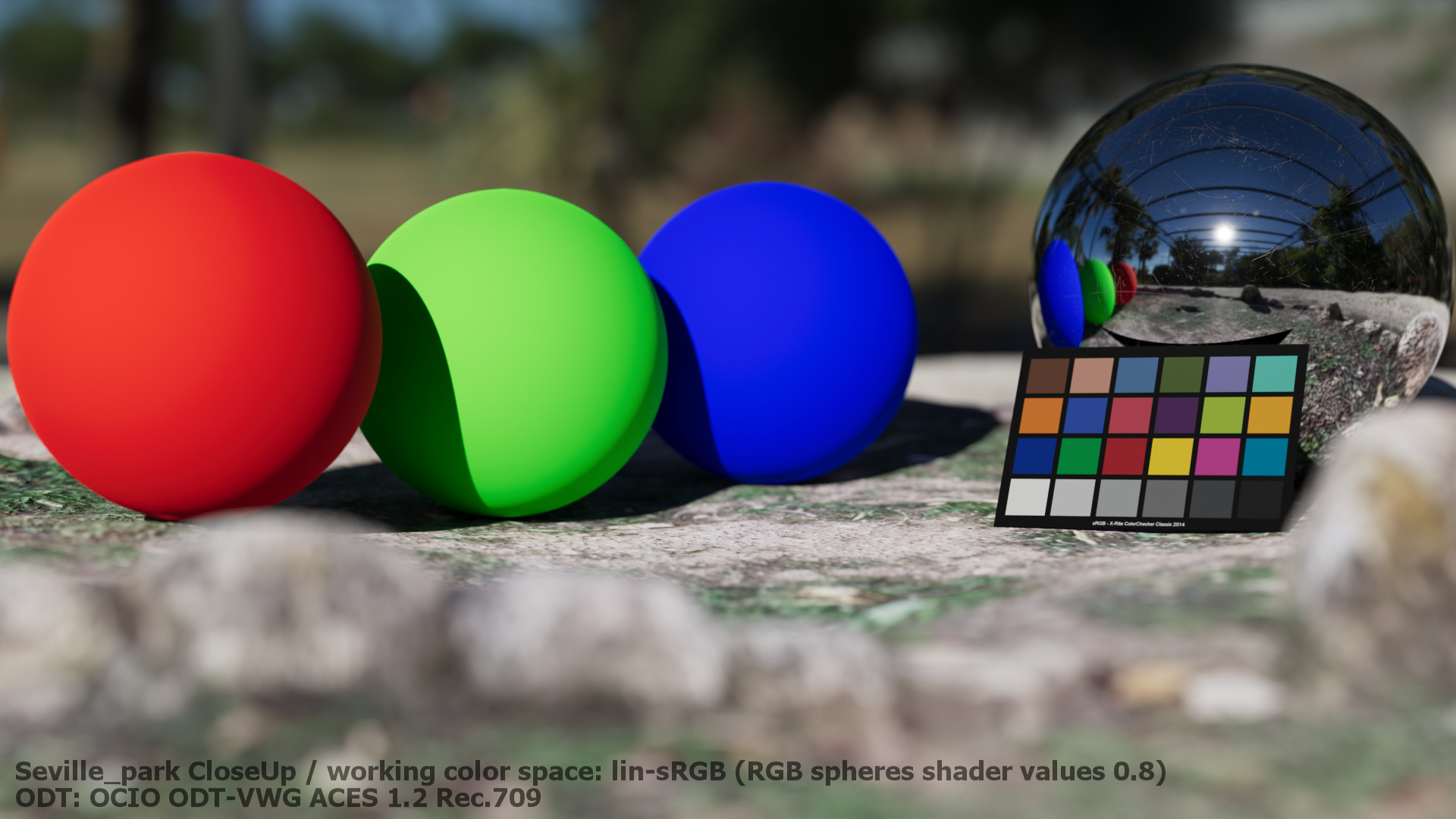
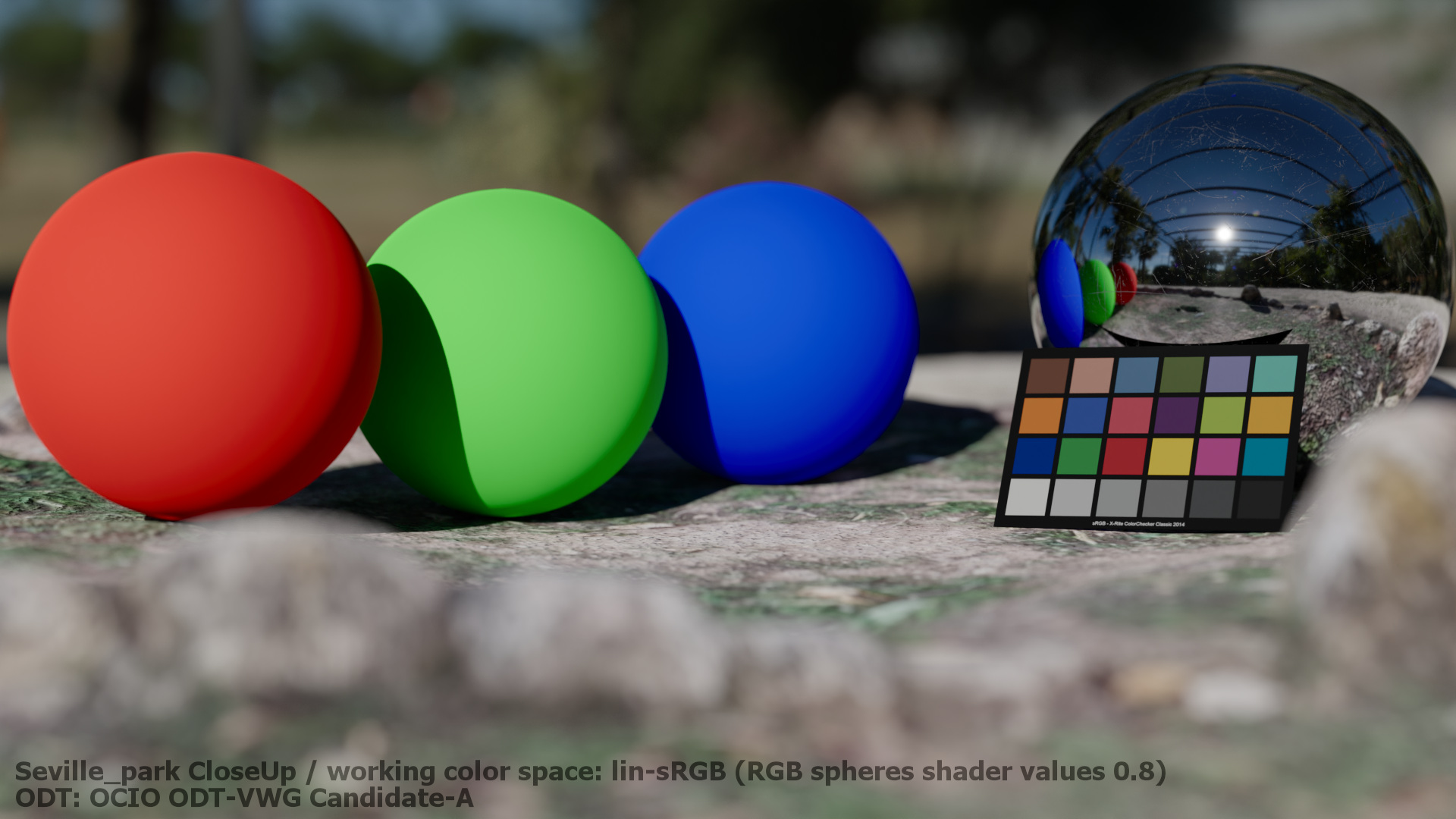
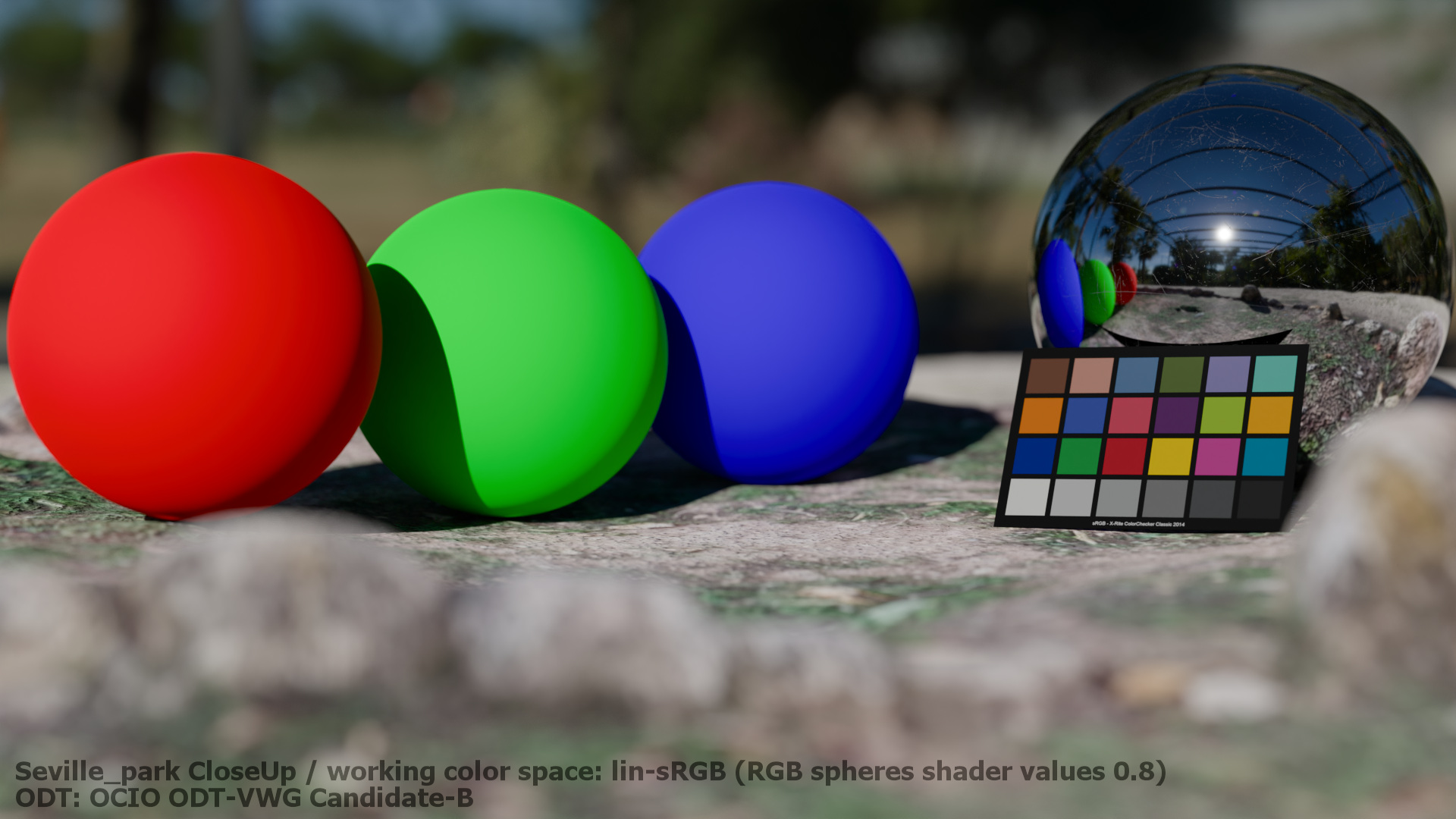

this was SDR, now its time for some HDR
The best way to view the HDR content is with the YouTube or Vimeo app directly on a device that supports HDR (EDR).
I have three HDR capable displays at the moment: An iPhone 13ProMax and an iPadPro, both with XDR displays and an iMac 27″ which has a 500 nits “HDR” display.
On the iMac only the YouTube links work in HDR and on the mobile devices I need to see the HDR clips directly in the YouTube and Vimeo apps.
The moment I uploaded the content on any platform I am not able to follow their compression and encoding processing. I can only hope that I will be able to see the same clip that I saw on my display. I am always uploading properly tagged ProRes4444 files to YouTube an Vimeo.
There is no HDR output transform for Blender Filmic and AgX available, but I added the Resolve RCM2 HDR output next to Open-DRT, T-Cam, ACES 1.2 and the three new ODT candidates.
To make the different HDR display rendering transform easier to compare I exposure adjusted each clip so that the middle grey patch ends up at 10 nits.
notes for the HDR clip
I opened up a H.265 clip on my iPad Pro with the XDR display via the files app and scrubbed through the clip to compare the results. The following notes refer most of the times to image before in the edit. Here is a download link for the file.
- ST-2084 EOTF PQ
- The most simple HDR rendering, just a switch of the EOTF in comparison to the SDR version. The sun highlight clips very sudden and with a hard edge.
- OpenDRT (0.1.3) Rec.2100 PQ
- More contrast than the first image, but overall the colours look the same. The spheres appear more round.
- Truelight Rec.2100 PQ
- Nearly identical result to OpenDRT, but the blue sphere is less saturated and appears in comparison a bit magenta.
- Resolve RCM2 (automatic settings for HDR processing and PQ output
- Comparing this image to the T-Cam result, especially the red and the blue sphere feel more saturated.
- VWG-ODT ACES 1.2 Rec.2100 (Nuke)
- The red sphere appears darker, the green sphere get a hint of a yellow-green tint and the blue sphere seems even more saturated and looses volume.
- VWG-ODT ACES 1.2 Rec.2100 (Resolve ACES no gamut compression)
- Especially the red sphere gets more orange, although this should be the same result as the image before.
- VWG-ODT Candidate-A Rec.2100 (Nuke)
- The green sphere gains more volume through more shading.
- VWG-ODT Candidate-A Rec.2100 (Resolve ACES no gamut compression)
- The overall image is slightly less saturated overall, although it should look identical to the image before?!
- VWG-ODT Candidate-B Rec.2100 (Nuke)
- Especially the blue sphere gets more saturated.
- VWG-ODT Candidate-B Rec.2100 (Resolve ACES no gamut compression)
- I can make out a slight shift to magenta in the blue sphere, although it should look identical to the image before?!
- VWG-ODT Candidate-C Rec.2100 (Nuke)
- A more drastic change in saturation. The blue seems to have a hint of a magenta appearance.
- VWG-ODT Candidate-C Rec.2100 (Resolve ACES no gamut compression)
- Overall a bit brighter, and the blue sphere gets some visible banding, although it should look identical to the image before?!
I have some unanswered questions:
- The working color space of the rendering is linear-sRGB. As far as I can see there are no out of gamut colours for sRGB appearing when the ACES IDT converts the EXR from linear-sRGB to ACEScg. But especially in Resolve I had to switch off the ACES 1.3 gamut compression, otherwise especially the blue sphere was rendered completely different.
- I will open a thread on ACESCentral.com to share this page and my questions there.
